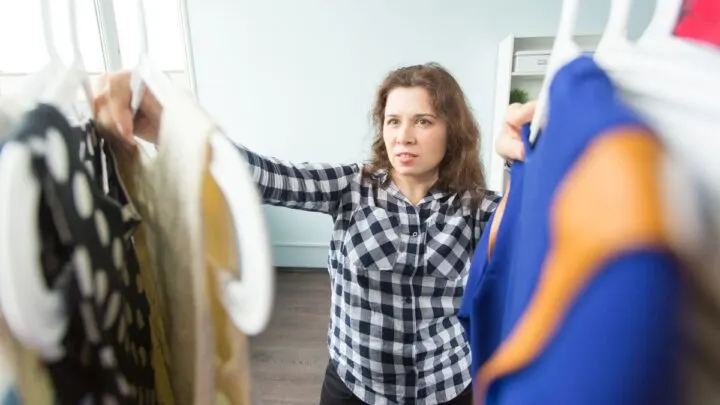Moths are terrible little critters who can eat through your most valuable fabrics.
You will know you have a moth infestation when you see tiny holes in all of your clothing.
Moth balls are a great substance that sends moths flying in the other direction, far away from your clothes.
How many mothballs should you use to keep them away but not cause your clothes to stink?
Only use two to four mothballs in your bedroom or closet. In a large room like a garage, you can use six to eight mothballs, although you may have to replace them from time to time.
The small balls might get eaten by any critters that find their way inside the garage.
If you do not get rid of moths when you first see them, eventually you will have to replace your entire wardrobe.
Just don’t place too many mothballs in your closet or your bedroom, or you may feel like you have a perpetual cold until the mothballs finally sublimate.

How Many Mothballs Should I Use?
The amount of mothballs it takes to kill and prevent moths depends on the size of the area the mothballs will be in.
If the room is too large, then the vapors cannot build up inside the room. The moths will survive flying through the vapor.
If the amount of mothballs is too many for a small room, then the moths will die quickly. But humans can develop throat and nose irritations and also nausea.
How Many Mothballs to Use in a Room?
Only use two to four moth balls in a smaller room, like a bedroom. You can use two mothballs in a small bedroom and four moth balls in a large bedroom like a master bedroom.
How Many Mothballs to Use in a Garage?
In a larger room with a lot of circulation, like a garage, use up to eight mothballs.
Place them in areas where cats, dogs, squirrels, and possums cannot eat them. Place them in dishes on top of some old furniture.
Place the mothballs close to anything with fabric like upholstered furniture and old clothing. Moths also love to eat paper.
If you have a lot of books, add some moth balls to the books boxes to keep the moths away.
How Many Mothballs to Use in a Closet?
A closet is a small space, so you shouldn’t need more than two or three moth balls.
If you place too many mothballs inside of the closet, your clothing will smell like mothballs. You’ll have to rewash everything in your closet.
What Is a Mothball and How Does It Work?
According to the EPA, a mothball is technically a pesticide. Gardeners use pesticides to control the number of insects that crawl into their garden.
Mothballs are tiny compressed balls of pesticide designed to keep away moths and other flying critters.
All mothballs contain naphthalene, which is a chemical made from crude oil. This chemical is also known as a fumigant insecticide.
Fumigate means that a substance turns into a vapor directly from a solid state. It doesn’t need to become a liquid to become a vapor.
Inhaling the scent of one mothball won’t overly harm humans, since we are much larger than moths.
But moths are minuscule. Breathing in the tiniest amount of vapor can kill a moth quickly. Moth balls can also kill moth larvae.
The moths can detect the toxic chemicals in the mothballs if they are far enough. But if it cannot detect the toxic mothballs and it gets too close, it can die within a few minutes.
Although they are called mothballs, mothballs can protect your clothing from roaches, water bugs, squirrels, deer, rats, skunks, snakes, and mites.
So taking mothballs with you camping is a good idea as this substance might prevent snakes and squirrels from eating your food and ripping apart your tent.
However, mothballs are not guaranteed to keep away these animals.
If you place mothballs down the floor of your campsite, don’t be surprised if some squirrels are raiding your cooler in the middle of the night.
What to Know About Mothballs
Only use these in places where there is good air flow. Do not seal them in clothing storage bags.
Don’t add too much to a room, garage, or closet. Humans can inhale the vapor and it can cause gastrointestinal issues such as abdominal cramps, nausea and diarrhea.
In the worst cases, you can also cause acute renal shutdown, which is another term for kidney failure.
Even if you only inhale a small amount of mothball vapor, it can immediately irritate the nose and the throat and cause headaches.
Moth balls should not be stored inside sealed containers, but don’t place them outside in open areas either. Outside, they are not as effective as they are indoors.
Mothballs really say small amounts of vapor which can build up in a rumor closet. The humans will not be affected but the moths will.
If mothballs are outside, there is no space for the vapor to build up. The moths will not die.
As long as the mothballs are in a room like a garage or a closet, they can last up to six months.

What To Do If Your Clothes Smell Like Mothballs
If you use too many mothballs and now your clothes smell like mothballs, wash your clothes to get the smell out.
While washing the entire contents of your closet is not fun, replacing your clothes because of moth bites is even worse.
Removing the mothball smell out of your clothing is relatively simple.
Just wash all of your clothes according to their wash instructions and then add some vinegar in the rinse cycle.
You only need a little vinegar. Just use about half a cup of vinegar for the entire load of clothing.
You’ll be surprised at how effectively vinegar removes terrible smells from clothing and fabric.
Conclusion to Using Mothballs
Mothballs are substances made with pesticides.
It can sublimate or go from a solid state directly to a vaporous state. A small closet should only need up to three mothballs.
A room like a bedroom or living room needs up to four muscles. And a large ventilated room like a garage needs up to eight mothballs.
If you smell mothballs on your clothes, wash your clothes and then pour half a cup of vinegar into the rinse cycle.


